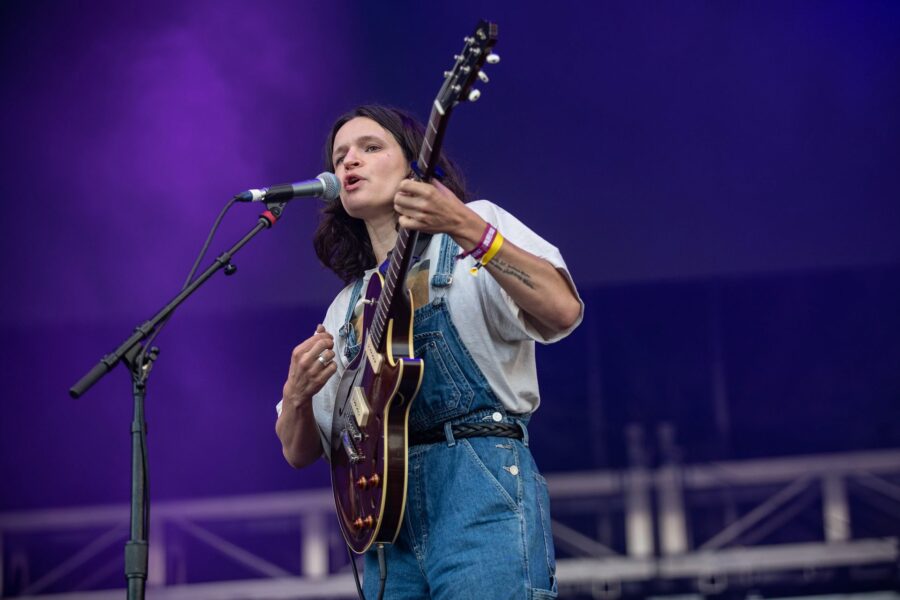Adrianne Lenker’s work offers a profound counter-narrative. The musician and visual artist operates with a quiet, yet radical intentionality, suggesting that true artistic power lies not in volume, but in vulnerability, and not in spectacle, but in intimacy. Lenker’s prolific output, both as the frontwoman of Big Thief and in her increasingly celebrated solo career, has solidified her position as a cornerstone of contemporary folk and indie rock. Yet, to categorize her solely by genre is to miss the broader significance of her practice. Her work functions as a kind of sonic sculpture, each song a carefully hewn artifact of feeling and observation, inviting us to reconsider what constitutes a meaningful engagement with music and art in an age of digital distraction.
The Architect of Intimacy: Lenker’s Artistic Lineage
Adrianne Lenker’s artistic lineage is less a direct inheritance and more a synthesis of disparate influences, a lineage rooted in a certain tradition of American confessionalism but refracted through a uniquely contemporary lens. Her work echoes the raw, unvarnished sincerity of artists like Townes Van Zandt, Joni Mitchell, and early Bob Dylan, whose lyrical mastery and emotional directness laid the groundwork for an entire generation of singer-songwriters. These figures, too, understood the power of the singular voice and the acoustic guitar as a conduit for profound, often painful, truths. Lenker, however, departs from this tradition by infusing it with a radical present-ness. While the folk revivalists of the 1960s often drew on historical narratives and political broadsides, Lenker’s focus is almost exclusively on the micro-details of lived experience, the sensation of a hand in a pocket, the specific quality of light in a room, the fractal complexity of a single relationship.
Born in Indianapolis in 1981, Lenker’s upbringing in a nomadic, religious household shaped her early worldview and, consequently, her artistic output. This transient lifestyle fostered a deep sense of observation and a reliance on internal landscapes. Her early immersion in music, she began performing professionally as a child, honed her technical skills but also imbued her with a professional skepticism of the music industry’s machinery. This dual experience of technical rigor and a spiritual, almost anti-establishment sensibility is a defining feature of her work. It’s a practice built not on grand narratives or commercial ambitions, but on the meticulous craft of songwriting, where each word and chord change feels both inevitable and surprising.
The Contemporary Canvas: Lenker in the Current Landscape
Today, Adrianne Lenker is a central figure in a resurgent indie-folk scene, a movement that prioritizes lyrical depth and instrumental nuance over commercial gloss. Her recent solo albums, Bright Future (2024) and Songs and Instrumentals (2020), have been met with near-universal critical acclaim, cementing her status as a generational songwriter. These works demonstrate a continued evolution in her sound, moving from the more densely arranged rock of her early Big Thief albums to a sparser, more intimate folk style. Bright Future, in particular, showcases an almost breathtaking economy of language and emotion. Tracks like “No Machine” and “Ruined” feel less like songs and more like overheard conversations or private confessions, rendered with a clarity that is both disarming and deeply affecting.
Lenker’s impact extends beyond her solo work. As the primary songwriter for Big Thief, she has guided the band to a level of commercial success and critical adulation that is rare for a group operating outside the mainstream. Their 2022 album, Dragon New Warm Mountain I Believe in You, was a sprawling, ambitious work that showcased Lenker’s ability to move between genres, from folk and country to more experimental, noise-inflected textures, while maintaining a singular artistic vision. The album’s success highlights a significant shift in the broader music industry, where audiences are increasingly willing to engage with complex, non-formulaic art. This is reflected in streaming data and critical reception. For instance, the album’s lead single, “Spud Infinity,” with its idiosyncratic lyrics and banjo-led arrangement, has garnered tens of millions of streams, a testament to the audience’s appetite for authenticity.
Moreover, Lenker’s work has found a home in the institutional art world. Her album releases are often accompanied by self-directed short films and visual media that explore themes of nature, memory, and the human form. These works, often shot on analog film, possess a lo-fi, textural quality that complements the warmth of her music. This interdisciplinary approach positions her not just as a musician, but as a multi-modal artist whose practice extends into visual and conceptual realms. This is a common thread among contemporary artists who are pushing the boundaries of their respective fields, blurring the lines between different forms of creative expression. Lenker’s work, with its emphasis on process, texture, and emotional honesty, is a prime example of this trend, resonating with a generation of creators who operate fluidly across different mediums.
The Critical Gaze: Examining the Aesthetics of Quietness
Despite the widespread praise, Lenker’s work is not without its critical ambiguities and potential dilemmas. One of the central debates surrounding her art is the aesthetic of quietness itself. Some critics, while appreciating the intimacy of her sound, have questioned whether the focus on personal, often melancholic narratives risks becoming insular or repetitive. The critic Hanif Abdurraqib, for example, has explored the power of the quiet song in a way that acknowledges its beauty while also raising questions about its political and social implications. In a world defined by large-scale injustices and political turmoil, is there a risk that such inward-focused music might inadvertently promote a form of artistic solipsism? This is a question not of intent, but of reception and cultural function.
The economic reality of Lenker’s artistic practice also presents a point of critical inquiry. While she has achieved success, her model of creation, touring relentlessly, recording with a small, trusted group of collaborators, and maintaining a low-profile public persona, stands in stark contrast to the dominant models of music industry success, which often rely on massive marketing campaigns and brand partnerships. This approach is admirable, but it also raises questions about sustainability. In a market where streaming royalties are notoriously low, can an artist maintain a career of this nature without significant institutional support or a dedicated, and often niche, audience? This is a dilemma that many independent artists face, and Lenker’s career, while a testament to artistic integrity, also serves as a case study in the challenges of monetizing a non-commercial artistic practice.
Furthermore, there is a fascinating tension between the rawness of Lenker’s recordings and the highly curated nature of her artistic persona. Her music is often presented as a kind of unmediated truth, captured live and with minimal post-production. Yet, as with any form of art, there is a degree of framing and choice involved. The very act of choosing what to share and what to withhold is a form of curation. This is not a critique of her authenticity, but rather an observation of the complex relationship between artistic honesty and the constructed nature of any public-facing persona. This is a discourse that has been explored by theorists such as Walter Benjamin, who examined the relationship between authenticity and reproducibility, and it is a debate that feels particularly relevant in the age of social media, where the boundary between the private and the public is constantly in flux.
The Next Movement: A Speculative Forecast
Looking ahead, Adrianne Lenker’s influence is poised to expand in several key ways. The most significant emerging trend is a move toward a more explicitly interdisciplinary practice. Having already established herself as a formidable songwriter and instrumentalist, her next phase may see her more deliberately engaging with other mediums. We might anticipate more self-directed films, visual installations, or even collaborations with other artists in different fields, painters, poets, or choreographers. This would be a natural extension of her aesthetic, which has always been deeply visual and textural.
Her impact on the next generation of musicians is also likely to be profound. In an era where the hyper-produced, trap-inflected sound has dominated the charts, Lenker’s success offers a powerful alternative model. Her work demonstrates that emotional depth, lyrical precision, and genuine instrumental skill are not relics of a bygone era, but rather enduring values that can resonate with a contemporary audience. We may see a new wave of artists who, inspired by her example, reject the pressure to conform to industry trends and instead focus on developing a unique and authentic voice. This would not be a mere stylistic imitation, but a philosophical inheritance, a commitment to craft over commercialism.
In the next 5-10 years, it is plausible that Lenker’s work will become a touchstone for discussions about authenticity in the digital age. As AI-generated music and hyper-synthesized sounds become more commonplace, the raw, human-centered art of Adrianne Lenker may be seen not just as a preference, but as a necessary counterpoint. Her music, with its fingerprints of human error and its embrace of sonic imperfections, will serve as a powerful reminder of the irreplaceable value of human touch in creative expression. Her career may thus become a central case study in the ongoing conversation about what it means to be a human artist in an increasingly automated world.
A Legacy in Resonance
Adrianne Lenker’s career is a compelling study in artistic integrity and the power of a gentle subversion. She reminds us that in a world that clamors for attention, the most profound statements can often be whispered. Her art is a testament to the enduring power of the human voice, the acoustic instrument, and the painstaking process of turning personal experience into universal resonance. In a cultural climate where spectacle often eclipses substance, Lenker’s legacy is likely to be one of quiet strength, an unwavering commitment to truth, beauty, and the delicate but enduring architecture of feeling. Her work does not offer definitive answers, but rather, invites us into a conversation about what it means to be seen and heard, not through the noise, but through the silence in between.









